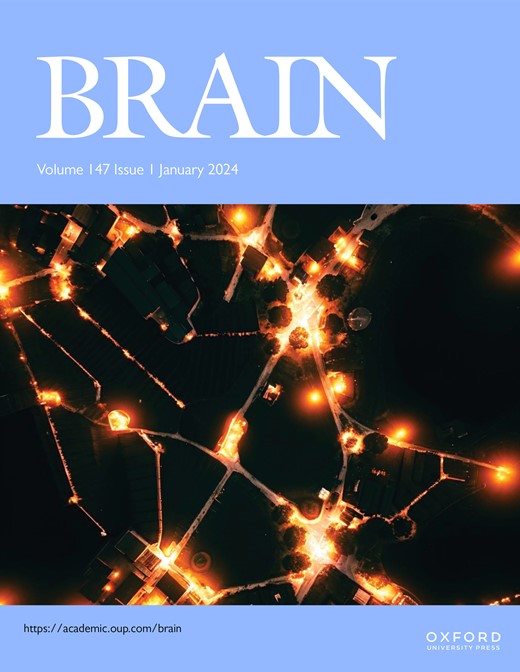用于创伤性脑损伤病理生理学分类的高维蛋白质组分析
IF 10.6
1区 医学
Q1 CLINICAL NEUROLOGY
引用次数: 0
摘要
创伤性脑损伤(TBI)后的病理生理学和结果复杂多样。目前的分类无法提供病理生理学方面的信息。使用基于体液的生物标记物的蛋白质组学方法是探索复杂疾病机制的理想方法,因为它们能对可能与 TBI 病理生理学相关的广泛过程进行敏感评估。我们使用新型高维多重蛋白质组测定法来评估急性创伤性脑损伤中血浆蛋白质表达的改变。我们在两个平台上分析了来自 BIO-AX-TBI 队列的 88 名参与者的样本(中度-重度 TBI [梅奥标准] 38 人,非 TBI 外伤 22 人,非损伤对照组 28 人):Alamar NULISA™ CNS Diseases 和 OLINK® Target 96 Inflammation。患者在入院后登记,并在受伤后 10 天内的单个时间点采集样本。参与者还获得了神经丝光、GFAP、总tau、UCH-L1(均为Simoa®)和S100B(密理博)的数据。Alamar 小组评估了 120 种蛋白质,其中大部分是以前在创伤性脑损伤中未探索过的,另外还有已知的创伤性脑损伤特异性蛋白质,如 GFAP。一个子集(N=29 TBI,N=24 非损伤对照组)还进行了亚急性(损伤后 10 天至 6 周)3T 磁共振成像测量病变体积和白质损伤(分数各向异性)。差异表达分析确定了 16 种蛋白质在 TBI 特异性血浆表达中存在显著差异。这些蛋白包括神经元标志物(calbindin2、UCH-L1、visinin-like protein1)、星形胶质细胞标志物(S100B、GFAP)、神经退行性疾病蛋白(总 tau、pTau231、PSEN1、淀粉样蛋白-β-42、14-3-3γ)、炎症细胞因子(IL16、CCL2、ficolin2)、细胞信号(SFRP1)、细胞代谢(MDH1)和自噬相关(sequestome1)蛋白。急性期血浆中 UCH-L1、PSEN1、总 tau 和 pTau231 的水平与亚急性病变体积相关。Sequestome1 与白质各向异性分数呈正相关,而 CLL2 则呈反相关。神经元、星形胶质细胞、tau 和神经退行性蛋白与 IL16、MDH1 和 sequestome1 相互关联。通过急性蛋白表达的探索性聚类(k均值)确定了3个创伤性脑损伤亚组,它们在损伤模式上存在差异,但在年龄或结果上没有差异。其中一个创伤性脑损伤分组的白质分数各向异性明显低于以对照组为主的分组,但其亚急性病变体积明显低于另一个创伤性脑损伤分组。在两个平台上重叠的蛋白质之间具有极好的相关性(r>0.8)。我们确定了参与神经退行性疾病、炎症和细胞过程的蛋白质的急性血浆水平在 TBI 中的特异性变化。这些变化与损伤模式有关,从而证明以前只在动物模型中研究的过程也与人类创伤性脑损伤病理生理学有关。我们的研究强调了蛋白质组学方法可如何改进创伤性脑损伤病理生理学的分类和理解,并对预后和治疗方法的开发产生影响。本文章由计算机程序翻译,如有差异,请以英文原文为准。
High-dimensional proteomic analysis for pathophysiological classification of traumatic brain injury
Pathophysiology and outcomes after Traumatic Brain Injury (TBI) are complex and heterogenous. Current classifications are uninformative about pathophysiology. Proteomic approaches with fluid-based biomarkers are ideal for exploring complex disease mechanisms, as they enable sensitive assessment of an expansive range of processes potentially relevant to TBI pathophysiology. We used novel high-dimensional, multiplex proteomic assays to assess altered plasma protein expression in acute TBI. We analysed samples from 88 participants from the BIO-AX-TBI cohort (n=38 moderate-severe TBI [Mayo Criteria], n=22 non-TBI trauma, n=28 non-injured controls) on two platforms: Alamar NULISA™ CNS Diseases and OLINK® Target 96 Inflammation. Patient participants were enrolled after hospital admission, and samples taken at a single timepoint up to 10 days post-injury. Participants also had neurofilament light, GFAP, total tau, UCH-L1 (all Simoa®) and S100B (Millipore) data. The Alamar panel assesses 120 proteins, most of which were previously unexplored in TBI, plus proteins with known TBI-specificity, such as GFAP. A subset (n=29 TBI, n=24 non-injured controls) also had subacute (10 days to 6 weeks post-injury) 3T MRI measures of lesion volume and white matter injury (fractional anisotropy). Differential Expression analysis identified 16 proteins with TBI-specific significantly different plasma expression. These were neuronal markers (calbindin2, UCH-L1, visinin-like protein1), astroglial markers (S100B, GFAP), neurodegenerative disease proteins (total tau, pTau231, PSEN1, amyloid-beta-42, 14-3-3γ), inflammatory cytokines (IL16, CCL2, ficolin2), cell signalling (SFRP1), cell metabolism (MDH1) and autophagy related (sequestome1) proteins. Acute plasma levels of UCH-L1, PSEN1, total tau and pTau231 correlated with subacute lesion volume. Sequestome1 was positively correlated, whilst CLL2 was inversely correlated, with white matter fractional anisotropy. Neuronal, astroglial, tau and neurodegenerative proteins correlated with each other, IL16, MDH1 and sequestome1. Exploratory clustering (k means) by acute protein expression identified 3 TBI subgroups that differed in injury patterns, but not age or outcome. One TBI cluster had significantly lower white matter fractional anisotropy than control-predominant clusters, but had significantly lower lesion subacute lesions volumes than another TBI cluster. Proteins that overlapped on two platforms had excellent (r>0.8) correlations between values. We identified TBI-specific changes in acute plasma levels of proteins involved in neurodegenerative disease, inflammatory and cellular processes. These changes were related to patterns of injury, thus demonstrating that processes previously only studied in animal models are also relevant in human TBI pathophysiology. Our study highlights how proteomic approaches might improve classification and understanding of TBI pathophysiology, with implications for prognostication and treatment development.
求助全文
通过发布文献求助,成功后即可免费获取论文全文。
去求助
来源期刊

Brain
医学-临床神经学
CiteScore
20.30
自引率
4.10%
发文量
458
审稿时长
3-6 weeks
期刊介绍:
Brain, a journal focused on clinical neurology and translational neuroscience, has been publishing landmark papers since 1878. The journal aims to expand its scope by including studies that shed light on disease mechanisms and conducting innovative clinical trials for brain disorders. With a wide range of topics covered, the Editorial Board represents the international readership and diverse coverage of the journal. Accepted articles are promptly posted online, typically within a few weeks of acceptance. As of 2022, Brain holds an impressive impact factor of 14.5, according to the Journal Citation Reports.
 求助内容:
求助内容: 应助结果提醒方式:
应助结果提醒方式:


